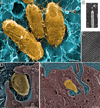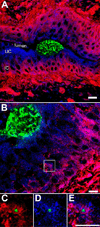Invasion of Host Cells and Tissues by Uropathogenic Bacteria
- PMID: 28087946
- PMCID: PMC5244466
- DOI: 10.1128/microbiolspec.UTI-0026-2016
Invasion of Host Cells and Tissues by Uropathogenic Bacteria
Abstract
Within the mammalian urinary tract uropathogenic bacteria face many challenges, including the shearing flow of urine, numerous antibacterial molecules, the bactericidal effects of phagocytes, and a scarcity of nutrients. These problems may be circumvented in part by the ability of uropathogenic Escherichia coli and several other uropathogens to invade the epithelial cells that line the urinary tract. By entering host cells, uropathogens can gain access to additional nutrients and protection from both host defenses and antibiotic treatments. Translocation through host cells can facilitate bacterial dissemination within the urinary tract, while the establishment of stable intracellular bacterial populations may create reservoirs for relapsing and chronic urinary tract infections. Here we review the mechanisms and consequences of host cell invasion by uropathogenic bacteria, with consideration of the defenses that are brought to bear against facultative intracellular pathogens within the urinary tract. The relevance of host cell invasion to the pathogenesis of urinary tract infections in human patients is also assessed, along with some of the emerging treatment options that build upon our growing understanding of the infectious life cycle of uropathogenic E. coli and other uropathogens.
Figures





References
Publication types
MeSH terms
Grants and funding
LinkOut - more resources
Full Text Sources
Other Literature Sources
Medical

